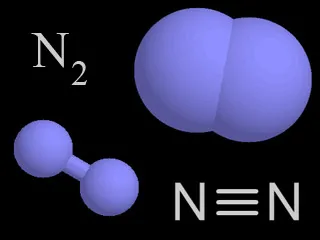Nitrogen
Molecular nitrogen (N2) – two nitrogen atoms tightly bound together – is a colorless, odorless, tasteless, and inert gas at normal temperatures and pressures.

Four representations chemists use for nitrogen molecules.
UCAR
About 78% of Earth's atmosphere is made up of molecular nitrogen (N2). There is a strong triple-bond between the nitrogen atoms, which is difficult to break apart. However, when these bonds do break, the resulting products are often highly reactive.
Nitrogen atoms are part of several types of pollutants. High temperature combustion in the presence of nitrogen gas, such as in automobile engines, can generate nitric oxide (NO) and nitrogen dioxide (NO2). Both gases are poisonous on their own, while they also play a role in the production of peroxyacetyl nitrate (PAN), a major component of smog, and nitric acid, which is part of acid rain.
Nitrogen gas can be used to manufacture ammonia (NH3), which is used extensively to produce chemical fertilizers.
Nitrogen is one of the most important elements in the chemistry of living creatures. For example, nitrogen is part of amino acids, the building blocks of proteins. The Nitrogen Cycle traces the path of nitrogen, in many different chemical forms, through the environment and living organisms. Certain microbes can take gaseous nitrogen from the air and convert it to ammonia, making it available to plants and other organisms in a process called "nitrogen fixation".
©UCAR with portions adapted from Windows to the Universe (©NESTA)